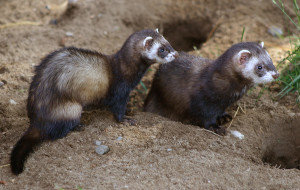 The European polecat is common throughout the region and is more frequent to places, where forests border on arable lands. It claims banks of rivers and brooks, thick shrubs, and low moors. The species does not avoid settling near humans. It mainly feeds on small vertebrates – rodents, frogs, and sometimes birds. Polecats stock up forage. They are nocturnal, and swim well. They build nests in tree roots, old stumps, field piles of rocks, brushwood, haystacks etc. – and even basements.
The European polecat is common throughout the region and is more frequent to places, where forests border on arable lands. It claims banks of rivers and brooks, thick shrubs, and low moors. The species does not avoid settling near humans. It mainly feeds on small vertebrates – rodents, frogs, and sometimes birds. Polecats stock up forage. They are nocturnal, and swim well. They build nests in tree roots, old stumps, field piles of rocks, brushwood, haystacks etc. – and even basements.
The economic significance of the ferrets is not merely determined by their precious hides – sold domestically and exported. Exterminating vast numbers of rats, mice and voles, they are of great use to agriculture and forestry. A polecat living next to a poultry house cannot be seen as a desirable neighbor, yet fighting it would also be a mistake. In harsh winters, rodents comprise over 80% of its nutrition. Since 1986 and to 1990, the average of 3.7 thousand hides per year was procured.
/ * The photos at lake.peipsi.org are cross-posted from commons.wikimedia.org and are used for familiarization purposes only. No commercial use of the photos is allowed. For more information about to use the photos see the originals on commons.wikimedia.org. /


